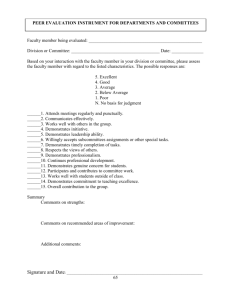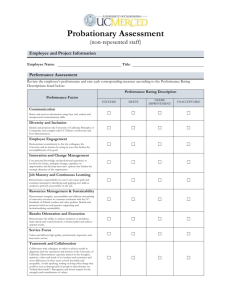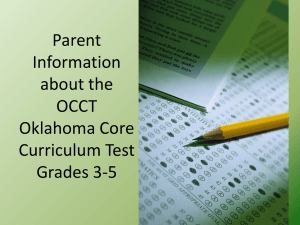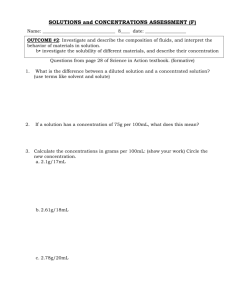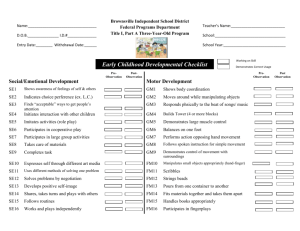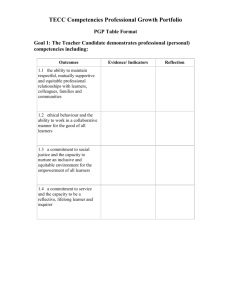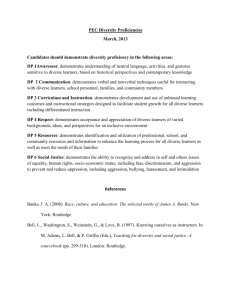here
advertisement
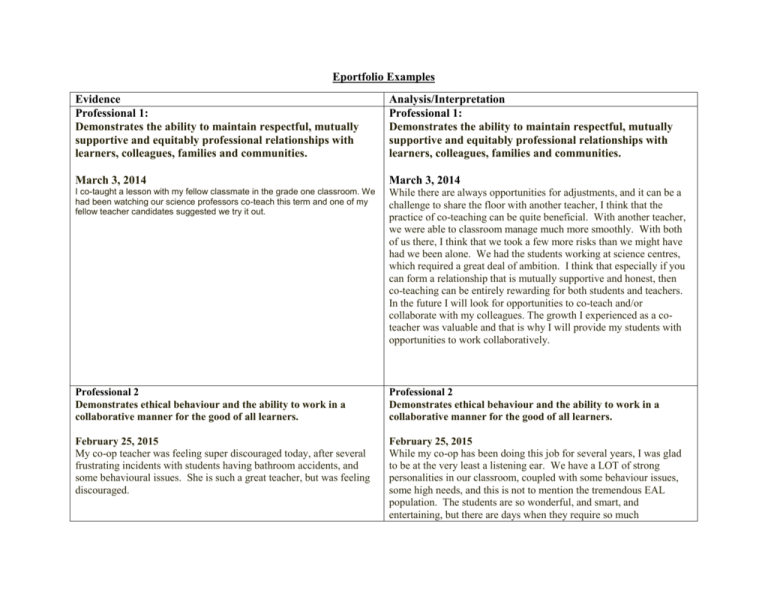
Eportfolio Examples Evidence Professional 1: Demonstrates the ability to maintain respectful, mutually supportive and equitably professional relationships with learners, colleagues, families and communities. Analysis/Interpretation Professional 1: Demonstrates the ability to maintain respectful, mutually supportive and equitably professional relationships with learners, colleagues, families and communities. March 3, 2014 March 3, 2014 I co-taught a lesson with my fellow classmate in the grade one classroom. We had been watching our science professors co-teach this term and one of my fellow teacher candidates suggested we try it out. While there are always opportunities for adjustments, and it can be a challenge to share the floor with another teacher, I think that the practice of co-teaching can be quite beneficial. With another teacher, we were able to classroom manage much more smoothly. With both of us there, I think that we took a few more risks than we might have had we been alone. We had the students working at science centres, which required a great deal of ambition. I think that especially if you can form a relationship that is mutually supportive and honest, then co-teaching can be entirely rewarding for both students and teachers. In the future I will look for opportunities to co-teach and/or collaborate with my colleagues. The growth I experienced as a coteacher was valuable and that is why I will provide my students with opportunities to work collaboratively. Professional 2 Demonstrates ethical behaviour and the ability to work in a collaborative manner for the good of all learners. Professional 2 Demonstrates ethical behaviour and the ability to work in a collaborative manner for the good of all learners. February 25, 2015 My co-op teacher was feeling super discouraged today, after several frustrating incidents with students having bathroom accidents, and some behavioural issues. She is such a great teacher, but was feeling discouraged. February 25, 2015 While my co-op has been doing this job for several years, I was glad to be at the very least a listening ear. We have a LOT of strong personalities in our classroom, coupled with some behaviour issues, some high needs, and this is not to mention the tremendous EAL population. The students are so wonderful, and smart, and entertaining, but there are days when they require so much work. Especially when there is a grade one classroom next door that seems to be sailing through all of the curriculum with ease. I understand how Kelley is feeling, and was able to remind her of the challenge of this particular class, and encourage her that she is a great teacher. I was just a voice of perspective. I was reminded of how important it will be for me to build strong relationships with my colleagues in the future. Professional 3 Demonstrates a commitment to social justice and the capacity to nurture an inclusive and equitable environment for the empowerment of all learners. March 10, 2015 During an English Language Arts lesson, I helped an EAL student express his ideas about the story being analyzed. Students were asked to make a prediction about how a particular story would end. The student in question clearly understood what he was supposed to do, but had difficulty getting his ideas on paper. I supported his learning by sitting with him one on one and helping him talk out his ideas. Next, I helped him to choose the proper words to describe his prediction. Through my aid, the student was able to complete the assignment and meet my cooperating teacher's expectations. Professional 4 Demonstrates a commitment to service and the capacity to be reflective, lifelong learners, and inquirers. January 14, 2015 During this week’s ECUR 322 (Science Methods) course, we discussed the value of inquiry based learning. In science (as well as all disciplines) learning through inquiry is an important task for students, because it facilitates deeper comprehension and draws on student curiosity. By learning about the multiple ways in which to create an inquiry based science lesson, I have discovered meaningful ways to teach science to elementary students. Professional 3 Demonstrates a commitment to social justice and the capacity to nurture an inclusive and equitable environment for the empowerment of all learners March 10, 2015 This interaction helped me to understand the different learning needs of the students within my teacher candidacy placement. Further, I am learning that not all individuals learn in the same way. Rather, there are many ways for students to learn and demonstrate their learning. Therefore, we have to provide students with the opportunity to demonstrate their learning in multiple ways, so that we can adequately assess their learning and create an inclusive environment that nurtures all students. Professional 4 Demonstrates a commitment to service and the capacity to be reflective, lifelong learners, and inquirers. January 14, 2015 I think that when I begin creating my own science lessons (during my teacher candidacy and internship), I will be able to integrate some form of inquiry. I will ask my co-op teacher if we can teach a simple inquiry based lesson so that I can experience the process of inquiry first hand. In doing this, I will gain confidence in using this teaching philosophy. Further, I will discover additional ways to integrate inquiry based learning into multiple subject areas. This is important, Knowledge 1 Demonstrates knowledge of Canadian History, especially in reference to Saskatchewan and Western Canada. November 15, 2014 Today I taught a Remembrance Day lesson to my grade one class. This lesson began with an overview of the purpose of Remembrance Day, as well as the things Canadians do on Remembrance Day. This lesson allowed me to teach the students about the Canadian soldiers who fought in multiple wars, and are still serving our country, today. Some of the students asked insightful questions, such as "Why were the countries involved in the war fighting?" I was able to answer this question, even though I was not expecting a grade one student to ask it! because there is a growing "push" to implement inquiry based learning into multiple subject areas. By learning about inquiry based learning, I have been able to see the merit behind developing this type of atmosphere for my future students. Knowledge 1 Demonstrates knowledge of Canadian History, especially in reference to Saskatchewan and Western Canada. Knowledge 2 Demonstrates proficiency in the Language of Instruction. November 15, 2014 I was able to provide my students with some background knowledge about Canada's role in war efforts, as well as the historical importance of Canadian soldiers. It was exciting for me to teach the students about a topic with which they had very little background knowledge. I believe that it is important for students to begin learning about Canada's past at a young age. Everyone in Canada should appreciate the effort made by past and present soldiers to give Canadians a great life. Before teaching this lesson, I was intimidated by the complexity of Canada's history and I was unsure of how to incorporate it into a grade one lesson. However, this lesson gave me confidence to continue to incorporate historical content into my lesson plans when it is relevant. In the future, I will consider meaningful way of discussing past events to supplement my lesson plans. Knowledge 2 Demonstrates proficiency in the Language of Instruction. March 11, 2015 March 11, 2015 Today I taught a St. Patrick's Day lesson to my grade one students. This lesson targeted both the English Language Arts and Arts Education curriculum. I planned to have the students complete a writing activity, and then move into their art activity. However, I made the mistake of explaining BOTH activities and then letting them work at each one at their own pace (i.e., the students were to complete their writing and then do the art project). I found that this encouraged my students to "rush" through the writing activity to begin working on the art project. My students were extremely excited for and engaged in the art activity, which was a positive aspect of my lesson. However, in the future I would explain the writing activity first and have the students complete it BEFORE I explain the art activity. I think that this would encourage my students to work hard on the writing activity instead of rushing through it. It is important for me to remember that my grade one students need A LOT of explanation about the activities we complete in class, and trying to do too many things at once can compromise the quality of their work. Knowledge 3 Demonstrates knowledge of First Nations, Metis & Inuit culture and History (e.g. Treaties, Residential School, Scrip, and Worldview) Knowledge 3 Demonstrates knowledge of First Nations, Metis & Inuit culture and History (e.g. Treaties, Residential School, Scrip, and Worldview) March 4, 2015 Today I taught a lesson about "What The Buffalo Gave.” The students learned that First Nations people used symbols to tell stories, and they often drew these symbols onto buffalo hide. Students completed an art activity. Brown paper was used to represent buffalo hide and students were instructed to use ONLY symbols to tell a story about their families. Then we had a sharing circle and the students shared their pictures with each other. The students were extremely intrigued in this lesson! March 4, 2015 This lesson gave me a sense of confidence in my ability to teach FNMI content at the grade one level. By teaching the students about the way in which First Nations people have traditionally told stories, I helped them to recognize both the similarities and differences between this culture and their own. Talking circles also allowed my students (and myself) to learn a lot about one another in the process. This is a lesson that I will definitely use in the future. Knowledge 4 Demonstrates ability to use technologies readily, strategically, and appropriately. Knowledge 4 Demonstrates ability to use technologies readily, strategically, and appropriately. I attended a Professional Development Opportunity that focused on an introduction to using SMART Board. By attending this professional development workshop, I learned how to effectively use SMART board. Now, I am aware of the multiple ways in which SMART board can be incorporated into classroom lessons for various subjects. I will now be able to use this tool throughout my teacher career! Additionally, my cooperating teacher uses SMART board constantly within her classroom, so I feel that it was a strategic choice to attend this professional development workshop. Knowledge 5 Knowledge 5 Demonstrates knowledge of a number of subjects taught in Saskatchewan schools (disciplinary/interdisciplinary knowledge) Demonstrates knowledge of a number of subjects taught in Saskatchewan schools (disciplinary/interdisciplinary knowledge) November 18, 2014 Today I helped instruct an Art lesson with a substitute teacher within my grade one classroom. During this lesson, students created super heroes out of construction paper, using the primary colours. The students were extremely enthusiastic about this activity, and they all seemed to really "tap into" their creativity. I acted as a scribe for the students, whereby I recorded their super hero's name and super power onto their project. After the students completed the super heroes, I created a bulletin board to display them. November 18, 2014 I was able to learn about a new area of the curriculum. I’m not very artistic so I was out of my comfort zone. When I got home, I looked at the Saskatchewan Art curriculum for grade one to see what outcomes and indicators this lesson hits. Instructing this lesson helped me to become interested in a new subject area. This is an important experience because as a teacher, I will often have to teach content that I am uncomfortable or unfamiliar with. I have a responsibility to my students to provide the best education possible regardless of my own feelings toward a subject. In the future, I will be more comfortable instructing in subject areas that are new to me. This experience has taught me the importance of having an open mind toward all teaching areas. Knowledge 6 Demonstrates ability to strive for/pursue new knowledge. Knowledge 6 Demonstrates ability to strive for/pursue new knowledge. March 18, 2015 Today I witnessed one of the LAT teachers at my placement school perform testing on a student in my grade one class. This student had been flagged to be examined for a learning disability in math and reading by an Education Psychologist because it is believed that she may have a learning disability. The student was tested one- on-one with the LAT teacher in a quiet room. Instructional 1 Demonstrates the ability to utilize meaningful, equitable and holistic approaches to assessment and evaluation. March 18, 2015 Observing this testing allowed me to gain insight into the screening process for learning disabilities. It is important for me to understand this process, because I will have to refer students for this type of assessment when I am a classroom teacher. I feel that I have a more comprehensive understanding of what skill testing looks like at the primary level. Instructional 1 Demonstrates the ability to utilize meaningful, equitable and holistic approaches to assessment and evaluation. February 10, 2015 February 10, 2015 I taught a grammar lesson in a grade four classroom today, which is not my typical classroom. It was a very interesting challenge to adjust my expectations from grade one to grade four. The lesson went very well, and I finished feeling quite confident that the students had met I really learned the value of assessment for learning during this lesson. It was not until I was reviewing the work that I realized what students had learned. Students had a much stronger grasp of the sentences with punctuation cues, than they did on the sentences where you needed to my learning goals. We do not do a great deal of formal or summative assessment in grade one. Most of the assessment comes from checking the student's books for their writing, checking their comprehension through observation and conversation. understand the intention. We discuss assessment as an important learning tool in all of our classes, and yet it wasn't until I experienced it firsthand that it really became clear to me how important it is. If this was my regular classroom I would now do a lesson on inferring and not focus on punctuation. Instructional 2 Demonstrates the ability to use a wide variety of responsive instructional strategies and methodologies to accomodate learning styles of individual learners and support their growth as social, intellectual, physical and spiritual beings. Instructional 2 Demonstrates the ability to use a wide variety of responsive instructional strategies and methodologies to accomodate learning styles of individual learners and support their growth as social, intellectual, physical and spiritual beings. March 5, 2015 March 5, 2015 My co-op teacher was describing the new math bins to the students this afternoon and the students were completely enthralled. She teaches math through the use of math centres or math bins. Each time she starts a new set of math bins, she takes a class to explain to the students what is in each bin, to rehearse the concepts, and to generally familiarize them. This doesn't sound like an overly engaging activity, but the students LOVE it. They are so excited to do math, and to start new math bins, that they are almost completely focused, hanging off every word that she says. One of the students clapped his hands and said, "I can't wait to start the math games!" Her centres are strategically building from one concept to another. Each student can work at their own ability level, interest and pace. They also can help each other co-construct knowledge. Even though it takes a lot of time to set up the math bins it is a valuable instructional strategy which I will use in the future. Curricular 1 Demonstrates knowledge of Saskatchewan curriculum and policy documents and applies this understanding to plan lessons, units of study and year plans using curriculum outcomes as outlined by the Saskatchewan Ministry of Education. Curricular 1 Demonstrates knowledge of Saskatchewan curriculum and policy documents and applies this understanding to plan lessons, units of study and year plans using curriculum outcomes as outlined by the Saskatchewan Ministry of Education. October 15, 2014 October 15, 2014 My co-op brought a pig heart into the grade one classroom today! She showed them the container, and had them guess what was inside. She removed the heart from her container, and showed all the parts to the students. They marveled at the shape and color! It was not at all what they had imagined. I think that the best part of the lesson is what happened next. She had the students line up, and she plopped that heart into their hands. They were able to touch, poke, and squeeze that heart. They got a true understanding of the size, of a heart, and how it works. She showed them how to thread their fingers through the openings, and to find the chambers in the heart. They compared the outside to the inside, identified fat, and veins, and came to understand what we mean when we say the heart is a muscle. It was an incredible lesson! This lesson was entirely memorable for these students, and they were discussing the heart that they had all touched for the rest of the day because of the hands on experience. My teacher was able to take the big idea out of the curriculum and make it real for her students. In the future, I will work hard not to get caught up in boring outcomes and indicators. Keep It Real!! Curricular 2 Demonstrates the ability to incorporate First Nations, Metis, and Inuit knowledge, content and perspectives into all teaching areas. Curricular 2 Demonstrates the ability to incorporate First Nations, Metis, and Inuit knowledge, content and perspectives into all teaching areas. March 11, 2015 I spoke with another post-intern who is working as an EA at my school today about ideas for incorporating First Nations content into the grade one science curriculum. March 11, 2015 I sincerely value the importance of incorporating FNMI content across the curriculum in a manner that is sincere and respectful. She gave me some really positive ideas as to how to naturally incorporate FNMI content into my science unit on the 5 senses. She recommended simply choosing a variety of materials for taste, touch and smell that are local, which automatically becomes inclusive of First Nations content. It is important to teach because it IS a part of our culture and community. It was a very encouraging discussion and a rich sharing of ideas. I will continue to look for local materials to enrich my FNMI content. Curricular 3 Demonstrates the capacity to engage in program planning to shape 'lived curriculum' that brings learner needs, subject matter, and contextual variables together in developmentally appropriate, culturally responsive and meaningful ways. Curricular 3 Demonstrates the capacity to engage in program planning to shape 'lived curriculum' that brings learner needs, subject matter, and contextual variables together in developmentally appropriate, culturally responsive and meaningful ways. January 8, 2015 January 8, 2015 In EDUC 312 (Relational Curriculum Making), I have learned that there are four interconnected parts in curriculum-making: student, teacher, context, and subject. It is essential that educators be aware of the interplay between each of these parts. In order to be an effective and competent teacher, educators must constantly be aware of themselves as individuals, their students, the context of their classroom, and the subject being taught This experience has confirmed my belief that education cannot take a "one-size-fits-all" approach. Rather, lessons and curriculum must be adapted and changed to accommodate the interplay between these four factors. It is important to take into consideration the individual needs of the students, rather than assuming that they all learn in the same way. Also, teachers must be aware of themselves as individuals. Throughout my career, I will work hard to take each of these factors into account during my curriculum planning to ensure that I provide the best education possible to my students and ensure that this education is relevant to the subject area and context of my classroom.
